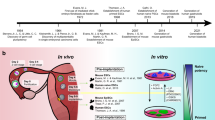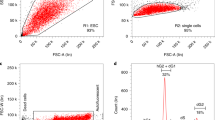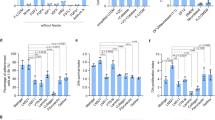Abstract
Human embryonic stem cells have been defined as self-renewing cells that can give rise to many types of cells of the body. How and whether these cells can be manipulated to replace cells in diseased tissues, used to screen drugs and toxins, or studied to better understand normal development, however, depends on knowing more about their fundamental properties. Many different human embryonic stem cell lines—which are pluripotent, proliferate indefinitely in vitro and maintain a normal, euploid karyotype over extended culture—have now been derived, but whether these cell lines are in fact equivalent remains unclear. It will therefore be important to define robust criteria for the assessment of both existing and newly derived cell lines and for the validation of new culture conditions.
This is a preview of subscription content, access via your institution
Access options
Subscribe to this journal
Receive 12 print issues and online access
$209.00 per year
only $17.42 per issue
Buy this article
- Purchase on Springer Link
- Instant access to full article PDF
Prices may be subject to local taxes which are calculated during checkout


Similar content being viewed by others
References
Thomson, J.A. et al. Embryonic stem cell lines derived from human blastocysts. Science 282, 1145–1147 (1998).
Richards, M., Fong, C.Y., Chan, W.K., Wong, P.C. & Bongso, A. Human feeders support prolonged undifferentiated growth of human inner cell masses and embryonic stem cells. Nat. Biotechnol. 20, 933–936 (2002).
Lanzendorf, S.E. et al. Use of human gametes obtained from anonymous donors for the production of human embryonic stem cell lines. Fertil. Steril. 76, 132–137 (2001).
Amit, M. & Itskovitz-Eldor, J. Derivation and spontaneous differentiation of human embryonic stem cells. J. Anat. 200, 225–232 (2002).
Reubinoff, B., Pera, M.F., Fong, C.Y. & Trounson, A. & Bongso, A. Embryonic stem cell lines from human blastocysts: somatic differentiation in vitro. Nat. Biotechnol. 18, 399–404 (2000).
Klimanskaya, I. et al. Human embryonic stem cells derived without feeder cells. Lancet 365, 1636–1641 (2005).
Lee, J.B. et al. Establishment and maintenance of human embryonic stem cell lines on human feeder cells derived from uterine endometrium under serum-free condition. Biol. Reprod. 72, 42–49 (2005).
Hovatta, O. et al. A culture system using human foreskin fibroblasts as feeder cells allows production of human embryonic stem cells. Hum. Reprod. 18, 1404–1409 (2003).
Simon, C. et al. First derivation in Spain of human embryonic stem cell lines: use of long-term cryopreserved embryos and animal-free conditions. Fertil. Steril. 83, 246–249 (2005).
Mitalipova, M. et al. Human embryonic stem cell lines derived from discarded embryos. Stem Cells 21, 521–526 (2003).
Cowan, C. et al. Derivation of embryonic stem-cell lines from human blastocysts. N. Engl. J. Med. 350, 1353–1356 (2004).
Oh, S.K. et al. Derivation and characterization of new human embryonic stem cell lines: SNUhES1, SNUhES2, and SNUhES3. Stem Cells 23, 211–219 (2005).
Zeng, X. et al. Properties of pluripotent human embryonic stem cells BG01 and BG02. Stem Cells 22, 292–312 (2004).
Strelchenko, N., Verlinsky, O., Kukharenko, V. & Verlinsky, Y. Morula-derived human embryonic stem cells. Reprod. Biomed. Online 9, 623–629 (2004).
Stojkovic, M. et al. Derivation of human embryonic stem cells from day-8 blastocysts recovered after three-step in vitro culture. Stem Cells 22, 790–797 (2004).
Andrews, P.W. et al. Pluripotent embryonal carcinoma clones derived from the human teratocarcinoma cell line Tera-2. Lab. Invest. 50, 147–162 (1984).
Carpenter, M. et al. Properties of four human ES cell lines maintained in a feeder free culture system. Dev. Dyn. 229, 243–258 (2004).
Kaufman, D.S., Hanson, E.T., Lewis, R.L., Auerbach, R. & Thomson, J.A. Hematopoietic colony-forming cells derived from human embryonic stem cells. Proc. Natl. Acad. Sci. USA 98, 10716–10721 (2001).
Rosler, E.S. et al. Long-term culture of human embryonic stem cells in feeder-free conditions. Dev. Dyn. 229, 259–274 (2004).
Amit, M. et al. Clonally derived human embryonic stem cell lines maintain pluripotency and proliferative potential for prolonged periods of culture. Developmental Biology 227, 271–278 (2000).
Amit, M., Shariki, C., Margulets, V. & Itskovitz-Eldor, J. Feeder layer- and serum-free culture of human embryonic stem cells. Biol. Reprod. 70, 837–845 (2004).
Okamoto, K. et al. A novel octamer binging transcription factor is differentially expressed in mouse embryonic stem cells. Cell 60, 461–472 (1990).
Rosner, M.H. et al. A POU-domain transcription factir in early stem cells and germ cells of the mammalian embryo. Nature 345, 686–692 (1990).
Yeom, Y.I. et al. Germline regulatory element of Oct-4 specific for the totipotent cycle of embryonal cells. Development 122, 881–894 (1996).
Nichols, J. et al. Formation of pluripotent stem cells in the mammalian embryo depends on the POU transcription factor Oct4. Cell 95, 379–391 (1998).
Lebkowski, J.S. et al. Human embryonic stem cells: culture, differentiation, and genetic modification for regenerative medicine applications. Cancer J. 7 suppl. Suppl. 2, S83–S93 (2001).
Nishimoto, M., Fukushima, A., Okuda, A. & Muramatsu, M. The gene for the embryonic stem cell coactivator UTF1 carries a regulatory element which selectively interacts with a complex composed of Oct-3/4 and Sox-2. Mol. Cell. Biol. 19, 5453–5465 (1999).
Ben-Shushan, E., Thompson, J., Gudas, L. & Bergman, Y. Rex-1, a gene encoding a transcription factor expressed in the early embryo, is regulated via Oct-3/4 and Oct-6 binding to an octamer site and a novel protein, Rox-1, binding to an adjacent site. Mol. Cell. Biol. 18, 1866–1878 (1998).
Kraft, H.J. et al. Oct-4 regulates alternative platelet-derived growth factor alpha receptor gene promoter in human embryonal carcinoma cells. J. Biol. Chem. 271, 12873–12878 (1996).
Niwa, H., Miyazaki, J. & Smith, A.G. Quantitative expression of Oct-3/4 defines differentiation, dedifferentiation or self-renewal of ES cells. Nat. Genet. 24, 372–376 (2000).
Mitsui, K. et al. The homeoprotein Nanog is required for maintenance of pluripotency in mouse epiblast and ES cells. Cell 113, 631–642 (2003).
Chambers, I. et al. Functional expression cloning of Nanog, a pluripotency sustaining factor in embryonic stem cells. Cell 113, 643–655 (2003).
Yuan, H., Corbi, N., Basilico, C. & Dailey, L. Developmental-specific activity of the FGF-4 enhancer requires the synergistic action of Sox2 and Oct-3. Genes Dev. 9, 2635–2645 (1995).
Niwa, H. Molecular mechanism to maintain stem cell renewal of ES cells. Cell Struct. Funct. 26, 137–148 (2001).
Abeyta, M.J. et al. Unique gene expression signatures of independently-derived human embryonic stem cell lines. Hum. Mol. Genet. 13, 601–608 (2004).
Bhattacharya, B. et al. Gene expression in human embryonic stem cell lines: unique molecular signature. Blood 103, 2956–2964 (2004).
Richards, M., Tan, S.P., Tan, J.H., Chan, W.K. & Bongso, A. The transcriptome profile of human embryonic stem cells as defined by SAGE. Stem Cells 22, 51–64 (2004).
Ginis, I. et al. Differences between human and mouse embryonic stem cells. Dev. Biol. 269, 360–380 (2004).
Brandenberger, R., Khrebukova, I., Thies, R.S., Miura, T., Jingli, C., Puri, R., Vasicek, T., Lebkowski, J. & Rao, M. MPSS profiling of human embryonic stem cells. BMC Dev. Biol. 4 (1):10 (2004).
Sperger, J.M. et al. Gene expression patterns in human embryonic stem cells and human pluripotent germ cell tumors. Proc. Natl. Acad. Sci. USA 100, 13350–13355 (2003).
Buzzard, J.J., Gough, N.M., Crook, J.M. & Coleman, A. Karyotype of human ES cells during extended culture. Nature Biotech. 22 (4), 381–382 (2004).
Draper, J.S. et al. Recurrent gain of chromosomes 17q and 12 in cultured human embryonic stem cells. Nat. Biotechnol. 22, 53–54 (2004).
Brimble, S.N. et al. Karyotypic stability, genotyping, differentiation, feeder-free maintenance, and gene expression sampling in three human embryonic stem cell lines derived prior to August 9, 2001. Stem Cells Dev. 13, 585–597 (2004).
Tjio, J. & Puck, T. Genetics of somatic mammalian cells. II. Chromosomal constitution of cells in tissue culture. J. Exp. Med. 108, 259–268 (1958).
Saksela, E. & Moorhead, P. Aneuploidy in the degenerative phase of serial cultivation of human cell strains. Proc. Natl. Acad. Sci. USA 50, 390–395 (1963).
Lalande, M. Parental imprinting and human disease. Annu. Rev. Genet. 30, 173–195 (1996).
Hall, J.G. Genomic imprinting: nature and clinical relevance. Annu. Rev. Med. 48, 35–44 (1997).
Smith, A.G. Embryo-derived stem cells: of mice and men. Annu. Rev. Cell Dev. Biol. 17, 435–462 (2001).
Rossant, J. Stem cells from the mammalian blastocyst. Stem Cells 19, 477–482 (2001).
Zwaka, T.P. & Thomson, J.A. A germ cell origin of embryonic stem cells? Development 132, 227–233 (2005).
Martin, M.J., Muotri, A., Gage, F. & Varki, A. Human embryonic stem cells express an immunogenic nonhuman sialic acid. Nat. Med. 11, 228–232 (2005).
Heins, N. et al. Derivation, characterization, and differentiation of human embryonic stem cells. Stem Cells 22, 367–376 (2004).
Xu, C. et al. Feeder-free growth of undifferentiated human embryonic stem cells. Nat. Biotechnol. 19, 971–974 (2001).
Sato, N., Meijer, L., Skaltsounis, L., Greengard, P. & Brivanlou, A.H. Maintenance of pluripotency in human and mouse embryonic stem cells through activation of Wnt signaling by a pharmacological GSK-3-specific inhibitor. Nat. Med. 10, 55–63 (2004).
Sato, N. et al. Molecular signature of human embryonic stem cells and its comparison with the mouse. Dev. Biol. 260, 404–413 (2003).
James, D., Levine, A., Besser, D. & Hemmati-Brivanlou, A. TGFβ/activin/nodal signaling is necessary for the maintence of pluripotency in human embryonic stem cells. Development 132, 1273–1282 (2005).
Xu, R.H. et al. Basic FGF and suppression of BMP signaling sustain undifferentiated proliferation of human ES cells. Nat. Methods 2, 185–190 (2005).
Xu, R.H. et al. BMP4 initiates human embryonic stem cell differentiation to trophoblast. Nat. Biotechnol. 20, 1261–1264 (2002).
Pera, M.F. et al. Regulation of human embryonic stem cell differentiation by BMP-2 and its antagonist noggin. J. Cell Sci. 117, 1269–1280 (2004).
Wang, L., Li, L., Menendez, P., Cerdan, C. & Bhatia, M. Human embryonic stem cells maintained in the absence of mouse embryonic fibroblasts or conditioned media are capable of hematopoietic development. Blood (2005).
Xu, C. et al. Basic fibroblast growth factor supports undifferentiated human embryonic stem cell growth without conditioned medium. Stem Cells 23, 315–323 (2005).
Kim, S.J. et al. Contribution of the PI3K/Akt/PKB signal pathway to maintenance of self-renewal in human embryonic stem cells. FEBS Lett. 579, 534–540 (2005).
Hwang, W.S. et al. Evidence of a pluripotent human embryonic stem cell line derived from a cloned blastocyst. Science 303, 1669–1674 (2004).
Park, S.P. et al. Establishment of human embryonic stem cell lines from frozen-thawed blastocysts using STO cell feeder layers. Hum. Reprod. 19, 676–684 (2004).
Suss-Toby, E., Gerecht-Nir, S., Amit, M., Manor, D. & Itskovitz-Eldor, J. Derivation of a diploid human embryonic stem cell line from a mononuclear zygote. Hum. Reprod. 19, 670–675 (2004).
Baharvand, H. et al. Establishment and in vitro differentiation of a new embryonic stem cell line from human blastocyst. Differentiation 72, 224–229 (2004).
Kim, S.J. et al. Efficient derivation of new human embryonic stem cell lines. Mol. Cells 19, 46–53 (2005).
Li, T., Zhou, C.Q., Mai, Q.Y. & Zhuang, G.L. Establishment of human embryonic stem cell line from gamete donors. Chin. Med. J. (Engl.) 118, 116–122 (2005).
Schuldiner, M., Yanuka, O., Itskovitz-Eldor, J., Melton, D.A. & Benvenisty, N. Effects of eight growth factors on the differentiation of cells derived from human embryonic stem cells. Proc. Natl. Acad. Sci. USA 97, 11307–11312 (2000).
Itskovitz-Eldor, J. et al. Differentiation of human embryonic stem cells into embryoid bodies comprising three embryonic germ layers. Mol. Med. 6, 88–95 (2000).
Dvash, T. et al. Temporal gene expression during differentiation of human embryonic stem cells and embryoid bodies. Hum. Reprod. 19, 2875–2883 (2004).
Kehat, I. et al. Human embryonic stem cells can differentiate into myocytes with structural and functional properties of cardiomyocytes. J. Clin. Invest. 108, 407–414 (2001).
Kehat, I., Gepstein, A., Spiro, A., Itskovitz-Eldor, J. & Gepstein, L. High-resolution electrophysiological assessment of human embryonic stem cell-derived cardiomyocytes. Circ. Res. 91, 659–661 (2002).
Xu, C., Police, S., Rao, N. & Carpenter, M.K. Characterization and enrichment of cardiomyocytes derived from human embryonic stem cells. Circ. Res. 91, 501–508 (2002).
Mummery, C. et al. Cardiomyocyte differentiation of mouse and human embryonic stem cells. J. Anat. 200, 233–242 (2002).
Kehat, I. et al. Development of cardiomyocytes from human ES cells. Methods Enzymol. 365, 461–473 (2003).
He, J.Q., Ma, Y., Lee, Y., Thomson, J.A. & Kamp, T.J. Human embryonic stem cells develop into multiple types of cardiac myocytes: action potential characterization. Circ. Res. 93, 32–39 (2003).
Mummery, C. et al. Differentiation of human embryonic stem cells to cardiomyocytes: role of coculture with visceral endoderm-like cells. Circulation 107, 2733–2740 (2003).
Snir, M. et al. Assessment of the ultrastructural and proliferative properties of human embryonic stem cell-derived cardiomyocytes. Am. J. Physiol. Heart Circ. Physiol. 285, H2355–H2363 (2003).
Satin, J. et al. Mechanism of spontaneous excitability in human embryonic stem cell derived cardiomyocytes. J. Physiol. (Lond.) 559, 479–496 (2004).
Xue, T. et al. Functional integration of electrically active cardiac derivatives from genetically engineered human embryonic stem cells with quiescent recipient ventricular cardiomyocytes: insights into the development of cell-based pacemakers. Circulation 111, 11–20 (2005).
Chadwick, K. et al. Cytokines and BMP-4 promote hematopoietic differentiation of human embryonic stem cells. Blood 102, 906–915 (2003).
Vodyanik, M.A., Bork, J.A., Thomson, J.A. & Slukvin, I.I. Human embryonic stem cell-derived CD34+ cells: efficient production in the coculture with OP9 stromal cells and analysis of lymphohematopoietic potential. Blood 105, 617–626 (2005).
Zhan, X. et al. Functional antigen-presenting leucocytes derived from human embryonic stem cells in vitro. Lancet 364, 163–171 (2004).
Levenberg, S., Golub, J.S., Amit, M., Itskovitz-Eldor, J. & Langer, R. Endothelial cells derived from human embryonic stem cells. Proc. Natl. Acad. Sci. USA 99, 4391–4396 (2002).
Wang, L. et al. Endothelial and hematopoietic cell fate of human embryonic stem cells originates from primitive endothelium with hemangioblastic properties. Immunity 21, 31–41 (2004).
Gerecht-Nir, S. et al. Vascular gene expression and phenotypic correlation during differentiation of human embryonic stem cells. Dev. Dyn. 232, 484–497 (2005).
Gerecht-Nir, S. et al. Vascular development in early human embryos and in teratomas derived from human embryonic stem cells. Biol. Reprod. 71, 2029–2036 (2004).
Gerecht-Nir, S., Cohen, S., Ziskind, A. & Itskovitz-Eldor, J. Three-dimensional porous alginate scaffolds provide a conducive environment for generation of well-vascularized embryoid bodies from human embryonic stem cells. Biotechnol. Bioeng. 88, 313–320 (2004).
Schuldiner, M. et al. Induced neuronal differentiation of human embryonic stem cells. Brain Res. 913, 201–205 (2001).
Carpenter, M.K. et al. Enrichment of neurons and neural precursors from human embryonic stem cells. Exp. Neurol. 172, 383–397 (2001).
Zhang, S.C., Wernig, M., Duncan, I.D., Brustle, O. & Thomson, J.A. In vitro differentiation of transplantable neural precursors from human embryonic stem cells. Nat. Biotechnol. 19, 1129–1133 (2001).
Reubinoff, B.E. et al. Neural progenitors from human embryonic stem cells. Nat. Biotechnol. 19, 1134–1140 (2001).
Schulz, T.C. et al. Directed neuronal differentiation of human embryonic stem cells. BMC Neurosci. 4, 27 (2003)
Ben-Hur, T. et al. Transplantation of human embryonic stem cell-derived neural progenitors improves behavioral deficit in Parkinsonian rats. Stem Cells 22, 1246–1255 (2004).
Perrier, A. et al. Derivation of midbrain dopamine neurons from human embryonic stem cells. Proc. Natl. Acad. Sci. USA 101, 12543–12548 (2004).
Schulz, T.C. et al. Differentiation of human embryonic stem cells to dopaminergic neurons in serum-free suspension culture. Stem Cells 22, 1218–1238 (2004).
Zeng, X. et al. Dopaminergic differentiation of human embryonic stem cells. Stem Cells 22, 925–940 (2004).
Park, S. et al. Generation of dopaminergic neurons in vitro from human embryonic stem cells treated with neurotrophic factors. Neurosci. Lett. 359, 99–103 (2004).
Li, X.J. et al. Specification of motoneurons from human embryonic stem cells. Nat. Biotechnol. 23, 215–221 (2005).
Nistor, G.I., Totoiu, M.O., Haque, N., Carpenter, M.K. & Keirstead, H.S. Human embryonic stem cells differentiate into oligodendrocytes in high purity and myelinate after spinal cord transplantation. Glia 49, 385–396 (2005).
Assady, S. et al. Insulin production by human embryonic stem cells. Diabetes 50, 1691–1697 (2001).
Segev, H., Fishman, B., Ziskind, A., Shulman, M. & Itskovitz-Eldor, J. Differentiation of human embryonic stem cells into insulin-producing clusters. Stem Cells 22, 265–274 (2004).
Rambhatla, L., Chiu, C.P., Kundu, P., Peng, Y. & Carpenter, M.K. Generation of hepatocyte-like cells from human embryonic stem cells. Cell Transplant. 12, 1–16 (2003).
Lavon, N., Yanuka, O. & Benvenisty, N. Differentiation and isolation of hepatic-like cells from human embryonic stem cells. Differentiation 72, 230–238 (2004).
Gerami-Naini, B. et al. Trophoblast differentiation in embryoid bodies derived from human embryonic stem cells. Endocrinology 145, 1517–1524 (2004).
Clark, A.T. et al. Spontaneous differentiation of germ cells from human embryonic stem cells in vitro. Hum. Mol. Genet. 13, 727–739 (2004).
Acknowledgements
This work was supported in part by the Krembil Foundation, and an establishment grant from the Canadian Institutes of Health Research awarded to M.K.C. and a postdoctoral fellowship from the Ontario Research and Development Challenge Fund awarded to L.M.H. Special thanks to Jennifer L. Batten for assistance with photomicrographs.
Author information
Authors and Affiliations
Corresponding author
Ethics declarations
Competing interests
The authors declare no competing financial interests.
Rights and permissions
About this article
Cite this article
Hoffman, L., Carpenter, M. Characterization and culture of human embryonic stem cells. Nat Biotechnol 23, 699–708 (2005). https://doi.org/10.1038/nbt1102
Published:
Issue Date:
DOI: https://doi.org/10.1038/nbt1102
This article is cited by
-
Therapeutic effects of mesenchymal stem cells-derived extracellular vesicles’ miRNAs on retinal regeneration: a review
Stem Cell Research & Therapy (2021)
-
Strategies for derivation of endothelial lineages from human stem cells
Stem Cell Research & Therapy (2019)
-
Islet-Like Structures Generated In Vitro from Adult Human Liver Stem Cells Revert Hyperglycemia in Diabetic SCID Mice
Stem Cell Reviews and Reports (2019)
-
Xeno-free culture of human pluripotent stem cells on oligopeptide-grafted hydrogels with various molecular designs
Scientific Reports (2017)
-
Comparison of a xeno-free and serum-free culture system for human embryonic stem cells with conventional culture systems
Stem Cell Research & Therapy (2016)



